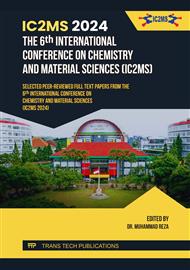[1]
Goldfarb, W. (2020). Water law. CRC Press.
Google Scholar
[2]
Meran, G., Siehlow, M., von Hirschhausen, C., Meran, G., Siehlow, M., & von Hirschhausen, C. (2021). Water availability: A hydrological view. The Economics of Water: Rules and Institutions, 9-21.
DOI: 10.1007/978-3-030-48485-9_2
Google Scholar
[3]
DITJEN DUKCAPIL. (2023). Data Kependudukan: Jumlah Penduduk Indonesia (Berdasarkan Kepemilikan NIK)
Google Scholar
[4]
Kucera, J. (2019). Desalination: water from water. John Wiley & Sons.
Google Scholar
[5]
Curto, D., Franzitta, V., & Guercio, A. (2021). A review of the water technologies. Applied Sciences, 11(2), 670.
DOI: 10.3390/app11020670
Google Scholar
[6]
Hua, W. S., Xu, H. J., & Xie, W. H. (2022). Review on adsorption materials and system configurations of the adsorption desalination applications. Applied Thermal Engineering, 204, 117958.
DOI: 10.1016/j.applthermaleng.2021.117958
Google Scholar
[7]
Saleh, T. A. (2021). Protocols for synthesis of nanomaterials, polymers, and green materials as adsorbents for water treatment technologies. Environmental Technology & Innovation, 24, 101821.
DOI: 10.1016/j.eti.2021.101821
Google Scholar
[8]
Nabil, Z. 2019. Pengenalan Terumbu Karang, Sebagai Pondasi Utama Laut Kita. Unimal Press. Hal. 7-8
Google Scholar
[9]
Lan, T., Dong, Y., Xu, Z., Zhang, Y., Jiang, L., Zhou, W., & Sui, X. (2023). Quercetin directed transformation of calcium carbonate into porous calcite and their application as delivery system for future foods. Biomaterials, 301, 122216.
DOI: 10.1016/j.biomaterials.2023.122216
Google Scholar
[10]
Sheng, X., Chen, S., Zhao, Z., Li, L., Zou, Y., Shi, H., ... & Cui, F. (2023). Rationally designed calcium carbonate multifunctional trap for contaminants adsorption. Science of The Total Environment, 166142.
DOI: 10.1016/j.scitotenv.2023.166142
Google Scholar
[11]
Sari, S. I. P., Wardhani, S., & Darjito, D. (2021). Pemanfaatan Cangkang Telur sebagai Bahan Baku Komposit CaCO3-Alginat untuk Adsorben Metil Jingga. The Indonesian Green Technology Journal, 10(2).
Google Scholar
[12]
Gao, X., Guo, C., Hao, J., Zhao, Z., Long, H., & Li, M. (2020). Adsorption Of Heavy Metal Ions By Sodium Alginate Based Adsorbent-A Review And New Perspectives. International journal of biological macromolecules, 164, 44234434
DOI: 10.1016/j.ijbiomac.2020.09.046
Google Scholar
[13]
Wen, Y., Xie, Z., Xue, S., Long, J., Shi, W., & Liu, Y. (2022). Preparation of novel polymethacryloyl hydrazone modified sodium alginate porous adsorbent with good stability and selective adsorption capacity towards metal ions. Separation and Purification Technology, 303, 122184.
DOI: 10.1016/j.seppur.2022.122184
Google Scholar
[14]
Hastuti, S., Nuryono. N., & Kuncaka, A. (2015). L-Arginine-Modified Silica for Adsorption of Gold (III). Universitas Sebelas Maret.
DOI: 10.22146/ijc.21203
Google Scholar
[15]
Dongyuan, Z., & Ying, W. (2007). Chapter 8 - The Synthesis of Mesoporous Molecular Sieves, Studies in Surface Science and Catalysis,Elsevier, Volume 168, Pages 241-III.
DOI: 10.1016/S0167-2991(07)80796-8
Google Scholar
[16]
Patty, S. I., Nurdiansah, D., & Akbar, N. (2020). Sebaran suhu, salinitas, kekeruhan dan kecerahan di perairan Laut Tumbak-Bentenan, Minahasa Tenggara. Jurnal Ilmu Kelautan Kepulauan, 3(1).
DOI: 10.33387/jikk.v3i1.1862
Google Scholar
[17]
Sadeghi, K., Thanakkasaranee, S., Lim, I., & Seo, J. (2020). Materials Science & Engineering C Calcined marine coral powders as a novel ecofriendly antimicrobial agent. Materials Science & Engineering C, 107(September 2019), 110193
DOI: 10.1016/j.msec.2019.110193
Google Scholar
[18]
Yu, W., Xue, Y., Mei, J., Zhou, X., Xiong, M., & Zhang, S. (2019). Segregation and removal of transition metal impurities during the directional solidification refining of silicon with Al-Si solvent. Journal of Alloys and Compounds, 805, 198-204.
DOI: 10.1016/j.jallcom.2019.07.089
Google Scholar
[19]
Siti, F., Nur, A., N., M., A., Khairul, A., M., A. (2019). Sodium Alginate Film: the Effect of Crosslinker on Physical and Mechanical Properties
Google Scholar
[20]
Kamisyah, S., Sapar, A., Brilliantoro, R., & Sayekti, E. (2020). Isolasi Dan Karakterisasi Alginat Dari Rumput Laut ( Sargassum polycystum ). 8(3), 62–71.
Google Scholar
[21]
Bt Ibrahim, S. F., Mohd Azam, N. A. N., & Amin, K. A. M. (2019). Sodium alginate film: The effect of crosslinker on physical and mechanical properties. IOP Conference Series: Materials Science and Engineering, 509(1)
DOI: 10.1088/1757-899X/509/1/012063
Google Scholar
[22]
Wuryani, M. A., Taufiq, A., & Fathurrahman, M. (2023). Utilization Of Tea Waste Activated By Using Hydrochloric Acid As An Adsorbent For Calcium ( Ii ) Ions In. 03(01), 13–20.
DOI: 10.33751/helium.v3i1.7930
Google Scholar
[23]
Musie, W., & Gonfa, G. (2022). Results in Engineering Adsorption of sodium from saline water with natural and acid activated Ethiopian bentonite. Results in Engineering, 14(May), 100440
DOI: 10.1016/j.rineng.2022.100440
Google Scholar
[24]
Endang, N. (2014). Comparison Of Matrix In Eps Immobilized Ca-Alginate Matrix With Eps Dispersed And Its Ability To Bio Sorption Cobalt, Strontium And Cesium. Prosiding Seminar Nasional Teknologi Pengelolaan Limbah XII. ISSN 1410-60806
Google Scholar
[25]
Zaini, H., Sami, M. (2017). Penyisihan Pb(II) Dalam Air Limbah Laboratorium Kimia Sistem Kolom dengan Bioadsorben Kulit Kacang Tanah. Ethos (Jurnal Penelitian dan Pengabdian Masyarakat). Vol 5 No 1
DOI: 10.29313/ethos.v0i0.2220
Google Scholar


